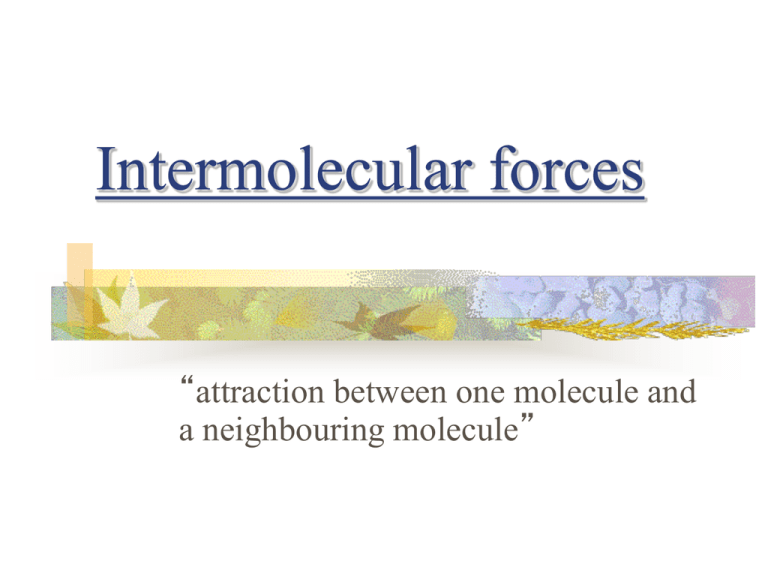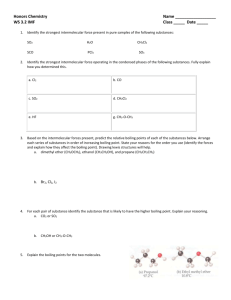Intermolecular forces
advertisement

Intermolecular forces “attraction between one molecule and a neighbouring molecule” Intermolecular forces Van Der Waal’s London forces Dipole-dipole Dipole- induced polarity Hydrogen bonding London forces Between non-polar molecules. Instantaneous polarity caused by the random. movement of electrons within a non-polar molecule (=temporary dipole). Instantaneous polarity induces polarity in neighbouring molecules. London forces is the attraction as a result of the polarity in neighbouring molecules. Weakest of the intermolecular forces and only acts over a short distance. London forces http://www.chemguide.co.uk/atoms/bonding/vdw.html . Strength depends on Number of electrons/molecular size Inert gas Boiling point (C) Halogen Boiling point (C) He -269 F -188 Ne -246 Cl -34.4 Ar -186 Br 58.8 Kr -152 I 184 Xe -108 At 337 Rn -62 Also depends on http://www.chemguide.co.uk/atoms/bonding/vdw.html Molecular shape Dipole-dipole http://www.teachmetuition.co.uk/Chemistry/Intermolecular/dipole.htm . Intermolecular forces between polar molecules Hydrogen bonding: evidence http://www.chemguide.co.uk/atoms/bonding/hbond.html#top Boiling points of group 4 hydrides Hydrogen bonding: evidence http://www.chemguide.co.uk/atoms/bonding/hbond.html#top Boiling points of group 5, 6 and 7 hydrides Hydrogen bonding: evidence http://www.chemguide.co.uk/atoms/bonding/hbond.html#top Boiling points of compounds with similar mass: ethanol, C2H5OH, (78 °C), methoxymethane, CH3OCH3 (-24.5 °C), propane, C3H8 (-44.5 °C), ethanal, CH3CHO (20.8 °C), Hydrogen bonding: evidence High solubility of ammonia in water (89.9 g/100 mol of water at 0°C) as hydrogen bonding occurs between ammonia and water molecules Strong forces between polymer molecules Ethanoic acid forms dimers in non-polar solvents so it has a high melting and boiling point Hydrogen bonding: water!! high surface tension high m.p./b.p. (water is a liquid over a wide range of temperatures) greater specific heat capacity than almost any other liquid high heat of vaporization structure of ice (lower density than water) Ice http://www.elmhurst.edu/~chm/vchembook/122Adensityice.html Ice http://chemistry.umeche.maine.edu/CHY132/Ice2.html Hydrogen bonding Strong attraction between highly positive hydrogen atom (part of a large dipole or polar bond i.e. bonded with N,O or F) the lone pair of a highly electronegative atom (usually N, O or F) of a neighbouring molecule (=intermolecular hydrogen bonds) or the same molecule (=intramolecular hydrogen bonds as in proteins). Strongest intermolecular force Hydrogen bonding http://users.rcn.com/jkimball.ma.ultranet/BiologyPages/H/HydrogenBonds.html Strength depends on: Polarity of H atom which depends on difference in electronegativity between H and N or O or F Number of hydrogen bonds most important factor e.g. water 2 per molecule Intermolecular forces Weakest: London forces (typically around 3 kJ/mol) Strongest: hydrogen bonding (typically around 30 kJ/mol) Molecules which can make hydrogen bonds will also make London and dipole-dipole; dipoles will also have London.






